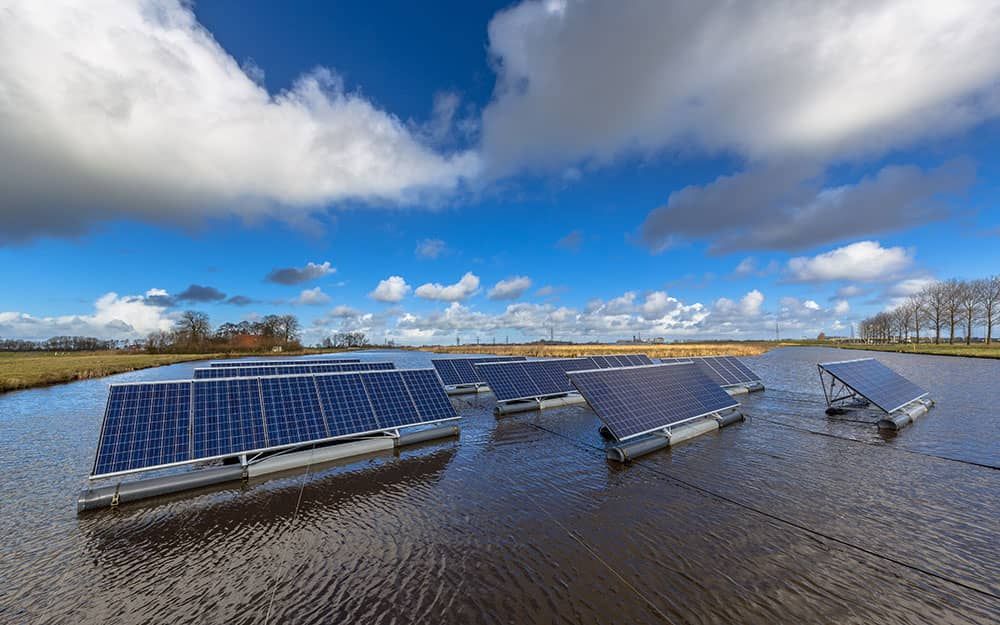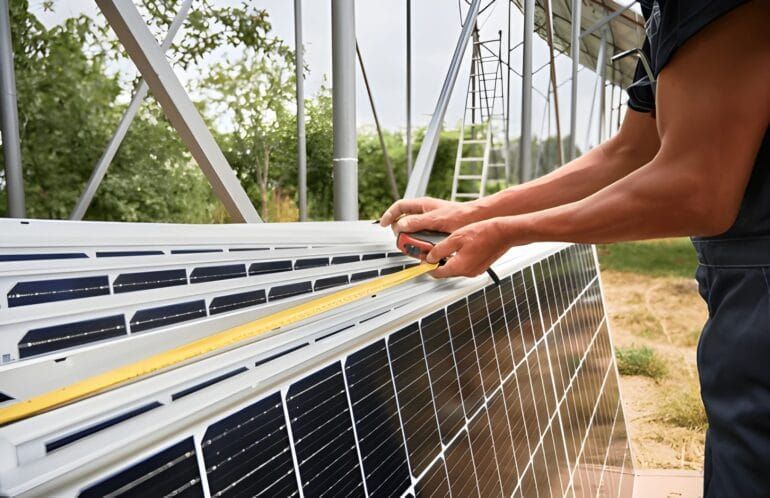Is the Future of Energy Floating Solar?
As the world continues to seek innovative and sustainable solutions to meet its growing energy needs, floating solar power has emerged as a promising technology. By harnessing the untapped potential of water bodies, such as reservoirs, lakes, and ponds, floating solar arrays offer unique advantages and pave the way for a greener future. In this article, we will explore the concept of floating solar and its potential to shape the future of energy generation.
Solar farms require massive land in order for them to operate. But land continues to be at premium prices in Australia. With demand for electricity going up each year, it’s time to look at other solutions. That’s where floating solar farms come in. Because they “float,” they can take up available water space, such as on dams and lakes.
Solar farms were introduced in the country because of the lack of roof space. Roofs may not have the needed structural integrity and pitch, too. Also known as ground-mount arrays, these solar farms are installed on vacant land next to electrical infrastructure. But with expensive land prices, no one was willing to purchase them to build solar farms. Property owners with ponds, lakes, and dams have decided to use their free space for floating solar islands.
Introduction
Floating solar represents a promising frontier in the field of renewable energy. With its ability to harness solar power on water bodies, it offers unique advantages over traditional land-based solar arrays. Optimal land use, enhanced efficiency, and positive environmental impacts make floating solar a compelling option for the future of energy generation.
While challenges such as platform durability and regulatory frameworks need to be addressed, ongoing technological advancements and supportive policies are driving the widespread adoption of floating solar. As countries and communities strive to transition to a cleaner and more sustainable energy mix, floating solar can play a significant role in meeting the growing demand for renewable power.
As we look ahead, it is clear that floating solar has the potential to revolutionize the energy landscape, opening up new opportunities for renewable power generation while preserving valuable land resources. By embracing this innovative technology, we can pave the way for a greener and more sustainable future.
What are These Floating Solar Systems?
Some people call floating solar “floatovoltaics.” They are designed to be on top of an irrigation dam, which means they stand on the surface of the water. These solar systems generate renewable energy, just like residential PV systems and traditional solar farms. The electricity they produce helps offset electricity consumption, which is distributed to residents or communities in the nearby area.
Floating solar farms were introduced many years back. They had gained traction mostly in 2018 when many countries opted to take advantage of this approach. These farms were built in countries that have high population density, especially those with limited available land.
This eco-friendly electric power generation method combines marine and renewable energy technologies. Instead of installing solar modules on residential or commercial roofs, they are placed on the surface of the water. Electricity will then be sent to a transmission tower through the cables installed underwater.
Benefits of Floating Solar Farms
Floating solar PV has plenty of benefits for Australians and the country, as well:
- More Efficient Land Use
Currently, we face a dilemma with wasted land space, which is one thing that the country aims to minimise in the future. But Australia has several available areas where floating solar can be installed.
Instead of taking up valuable land space, PV energy systems can be set up on the surface of the water. These systems do not require construction that takes place on land. Forests are left alone because there is no need to convert them to an area where solar PV can be accommodated. Farmlands are untouched, as well. As a result, land can be used for other meaningful purposes.
- High Energy Yield
Floating solar provides increased energy generation. That’s because of its location, which is on the water surface. Water helps keep the system cool, which reduces inefficiencies due to high heat. The constant rise in temperature of the modules can cause their quick deterioration. While these solar modules were designed to be used under the sun, they are still vulnerable to extreme temperature damage. Being on the water increases the cooling capacity of the solar panels by up to 12.5%.
- Water Saver
Floating solar can actually help lower water evaporation, which is a natural occurrence in the reservoir. Floatovoltaics block sunlight, which is effective in reducing water molecules that escape into the air.
- Eco-Friendly
Fish farms can continue thriving while floating solar is above water. It can even control algae growth. Floating solar also contributes to reducing the effects of climate change by cooling down lakes. It dramatically lowers the amount of sunlight reaching the body of water’s surface by 10 per cent. If several of these floating solar farms are installed across the country, we can enjoy an exceptional cooling effect. At the same time, lakes will experience better oxygenation, which is vital to aquatic plants and animals.
Advancing the Future of Energy
Floating solar has the potential to advance the future of energy in several significant ways. Let’s explore the key factors driving its growth and impact:
Increasing Energy Generation Capacity:
By utilizing underutilized water bodies, floating solar expands the potential for renewable energy generation. Reservoirs, lakes, and ponds can be transformed into clean power-generating assets, maximizing their dual-purpose functionality.
Expanding Access to Renewable Energy:
Floating solar enables regions with limited available land for solar installations to tap into the vast potential of water surfaces. This opens up new opportunities for communities, industries, and even remote areas to access sustainable and affordable energy.
Combating Land Constraints:
With the rapid growth of urbanization and competing land-use demands, finding suitable land for large-scale solar installations can be a challenge. Floating solar provides a practical solution by utilizing existing water bodies, helping overcome land constraints and reducing the need for extensive land acquisition.
Environmental Benefits:
Floating solar offers a range of environmental advantages, including:
Reducing Carbon Footprint:
By generating clean and renewable energy, floating solar contributes to reducing greenhouse gas emissions, helping combat climate change and air pollution.
Conserving Land and Biodiversity:
The installation of solar panels on water bodies minimizes the need for land clearing, preserving natural habitats and biodiversity hotspots.
Mitigating Water Evaporation:
By providing shade and reducing water surface exposure to sunlight, floating solar arrays can help mitigate water evaporation, particularly in arid and water-stressed regions.
Overcoming Challenges:
The widespread adoption of floating solar is not without its challenges, but ongoing advancements and proactive measures can address these issues:
Floating Platform Durability:
Designing durable and resilient floating platforms that can withstand various environmental conditions, such as waves, wind, and corrosion, is essential for long-term operation and maintenance.
Technological Advancements:
Continued research and development in floating solar technologies, such as efficient solar panel designs, innovative anchoring systems, and improved cable management, will enhance performance and reduce costs.
Regulatory and Policy Frameworks:
Establishing supportive regulatory frameworks and policies that encourage the development of floating solar projects, including streamlined permitting processes and incentives, can accelerate its deployment and integration into national energy strategies.
The Future of Floating Solar Farms in Australia
Water, compared to land, is a lazy asset, especially in Australia. It’s just like a boat – if it’s not used, it most probably costs money. And in recent times, solar has moved quickly. That includes floating solar, which is now a growing industry on its own. Despite the growth, it appears that floating solar farms are in an indeterminate state between commercialisation and start-up.
There is so much potential for floating solar in the country. But many are still reluctant to join in, especially with an adoption rate of 1-4MW. In other countries, it’s a lot higher, ranging from 50MW to 200MW.
Nevertheless, Australia is beginning to implement and install floating solar systems. Since 2015, a farm in South Australia has already been in operation. SA is the first ever to apply floating solar in the country at a wastewater treatment plant located in Jamestown, which is 200km north of Adelaide. The $17.5 million island comprises a system with 112 panels. To prevent overheating, the system uses the body of water and special technologies to increase output further.
Plus, it is also where the largest solar farm in the nation is found, which is the Bungala in Port Augusta. It’s no wonder that SA leads the country’s adoption of renewable power. Almost half of its electricity comes from solar panels and other sources.
The case for floating solar farms in the country is significant. There are so many bodies of water that are currently left alone when they should be used to help reduce electricity production from fossil fuels. Floating solar does not require a large capital investment.
Additionally, floating solar benefits the ecosystem. And with a cooler environment, solar panels are more efficient. Water temperatures are generally around 25 degrees Celsius, even in the summer. That means the output losses are minimal, allowing the panels to operate how they are intended.
Conclusion
In conclusion, floating solar presents a promising and innovative approach to energy generation, leveraging the untapped potential of water bodies. By expanding access to renewable energy, addressing land constraints, and offering environmental benefits, floating solar can play a crucial role in shaping the future of clean and sustainable energy. As technological advancements continue and supportive policies are put in place, we can expect to see a broader adoption of floating solar, contributing to a greener and more resilient energy landscape.
FAQs
Q: What are the benefits of floating solar compared to land-based solar arrays?
- A: Floating solar offers optimal land use, enhanced efficiency, reduced evaporation, and improved water quality.
Q: What types of water bodies are compatible with floating solar installations?
- A: Floating solar can be installed on reservoirs, lakes, ponds, coastal areas, and even offshore locations.
Q: How does floating solar contribute to environmental conservation?
- A: Floating solar reduces carbon emissions, conserves land and biodiversity, and mitigates water evaporation.
Q: What challenges need to be overcome for the widespread adoption of floating solar?
- A: Challenges include ensuring platform durability, advancing technological capabilities, and establishing supportive regulatory and policy frameworks.







